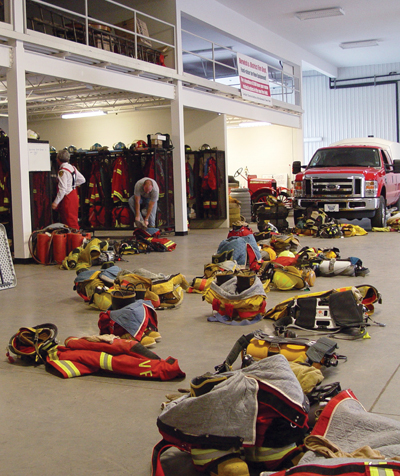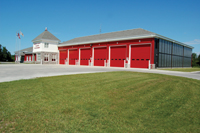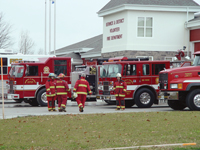
News
Green machine
CURRENT ISSUE
Green machine
Fire Fighting in Canada contributor Caroll McCormick takes a look at the new green fire department in Berwick, N.S., a station designed by firefighters for firefighters.
August 10, 2010
By Carroll McCormick
August 2010 – Standing sentinel at the north entrance of Berwick, Nova Scotia, is a remarkable fire hall: At 1,393 square metres, its annual energy bill is roughly equal to that required for the 520-square-metre building the Berwick & District Volunteer Fire Department vacated in November 2008.
 |
|
| The fire hall in Berwick, N.S., features in-floor radiant heating, steel mesh clothes lockers and ceiling-mounted air handling units that filter the air without having to open the bay doors. Photo by james morse
|
|
The spare, almost austere lines of the brick- and steel-clad structure symbolize the no-nonsense approach of a team of Berwick volunteer firefighters and other stakeholders in realizing their dream – a fire hall designed by firefighters, for firefighters. Thanks to a depth of expertise on the team in several building trades, tanker-loads of sweat equity and the backing of a town and district commission committed to green principles, firefighters have what they need and taxpayers are guaranteed predictable long-term operating costs.
The $2.5-million fire hall includes a six-door apparatus bay, administrative offices and a rental hall. Remarkably, it uses no heating oil. Rather, it is warmed by an in-floor radiant heat system with its water heated by solar collectors, roof-mounted heat pumps for fast heating of administrative offices and recreation hall and backup electrical heat for the coldest, darkest days.
“When oil was $150 a barrel in 2008, we were scared,” says Bob Ashley, Berwick’s chief administrative officer. “There is a certain confidence and added security being oil-independent. It is one less major civic building that will be a major drain on the public purse. From my point of view, I like having the security of not having to rely on oil.”
The green features of the fire hall are layered like an onion: The entire south wall is covered with 34 liquid, flat-plate solar collectors, totalling 101 square metres. Rather than design the building so the collectors could sit at the 45 degree angle that is optimal for the latitude, the design team determined it was less costly to simply add more panels.
“It is cheaper to add 10 per cent more panels and mount them vertically,” explains Steve McMahon, a Berwick deputy chief. “We worked backward from the building design.”
McMahon has 25 years’ experience in the industrial electrical equipment field. He and team chairman Capt. Mark Marchant, Chief Laurie Saunders and Deputy Chief Ken Redden made up a key group of firefighters who were involved in the building design from the project’s inception.
The vertical installation of the solar collectors offers two other advantages: no snow accumulation; and a high, inefficient angle of incidence in the summer when the sun is high and heating is undesirable.

|
|
| A lot of pride was invested in having the green fire hall as a gateway marker into Berwick, says chief administrative officer Bob Ashley. Photo by james morse
|
About 38 litres of glycol circulate from the collectors through solar panel-powered pumps to two heat exchangers in the mechanical room. The glycol’s heat is transferred via heat exchangers to water that circulates through three kilometres of tubing in the concrete floor.
The system is designed to heat the apparatus bay to a maximum of 15 C – plenty warm for crew in constant movement; extra coils of tubing buried under the steel-mesh lockers – an airy, in-house invention – help to dry soaked gear. The glycol also preheats water destined for the hot water tank.
The air-to-air heat pumps, with electric element boosters, provide quick warming: A 10-ton unit with 27 kilowatts of electric backup heats the recreation hall. A seven-ton unit with 27 kilowatts of electric backup heats the administration section.
Extra money was spent to insulate the fire hall to twice the standard required by code: R20 for the floor; R40 for the walls; and R60 for the ceilings.
The fire hall has several interior green features. For example, there are automatic light switches, automatic taps in the washrooms and auto-flush urinals. Each fire truck is equipped with a remote door opener, an energy saving convenience the old fire hall lacked.
“In the old days,” McMahon says (already, anything before November 2008 is the old days), “the trucks would leave the hall and the doors would stay open until someone happened along who thought to close them. This was a particular problem during daytime work week calls when manpower was tight.”
Another energy-saving feature the firefighters have to play with, literally, thanks to sheer inspiration and a big yard, is a 15.2-metre by 31-metre by 2.4-metre deep pond fed by rainwater collected from the fire hall roof. Now, instead of filling a tanker from the outflow of the Ducks Unlimited pond about five kilometres away, crews simply tap into their own 1,135-million-litre reservoir behind the fire hall.
One might think that Berwick (to be precise, the fire hall is a co-owned joint venture: 50 per cent by the Town of Berwick and 50 per cent by the Fire Commission for the District of Berwick) spared absolutely no expense to save a watt. But the designers, that savvy team of firefighters and local stakeholders, took a solidly earthbound approach to selecting hardware.
 |
|
| The Berwick Fire Department collaborated with the municipality to build the green fire hall. Photo by Carroll McCormick |
For example, they specified plain vanilla, locally available light fixtures and T8 bulbs. “We could have had a very minor efficiency gain by going to T5 lamps for instance, McMahon says. “However, the initial cost and lamp replacement cost made this impractical. Our guiding principle was to go with the best value, both long and short term. The other way to look at it was we were looking for the lowest cost of ownership.”
Truth be known, the mandate that drove the fire hall’s construction was not to build green purely on principle and damn the horses, but to select the most cost-effective, long-term solution. To figure this out, Berwick hired Acadia Management Group Inc., located in nearby Port Williams, to examine the alternatives.
“I was asked to come up with the most effective heating solution for the fire hall,” says AMG CEO Dr. James Retallack. “I was not asked to provide the best green alternative. I could have come back and said that oil heat was the best solution.”
It so happens that Kingston, a town a few kilometres west of Berwick, built a fire hall in 1998 that is oil heated and roughly the same size as the one Berwick wanted to build.
“I compared all the electricity and heating requirements, their costs and what they used. Steve is a big fan of solar and he understood that the temperature in the apparatus bay could be much lower and the firefighters still be comfortable,” Dr. Retallack explains. His point is that the right way to choose an optimal heating solution is to first understand the needs of the occupants and then select a solution that best meets those needs.
The long and the short of Dr. Retallack’s analysis was that a solar collector, in-floor solution would save $200,000 in heating costs over 10 years, compared to conventional oil heating. There was another revelation: “The surprising thing was that the original equipment cost was lower than a conventional system. This made their decision extremely straightforward,” Dr. Retallack says.
And the result of this 10-year effort: the planning, fundraising, grant chasing and construction? “We have a building that the community can be proud of,” Ashley, the Berwick CEO, says. “Firefighters like working in nice, safe facilities. We are having trouble attracting firefighters in Nova Scotia. How better to attract the next generation of firefighters.”
Carroll McCormick is a Montreal-based writer.
Print this page